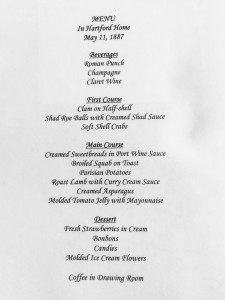Built in 1874, the Mark Twain House in Hartford is as artful and rich in detail as everything the world-famous author wrote. It fell into disrepair after the Clemens family sold it in 1903 and was very nearly razed, but it has been restored to its original splendor and is a must-see for fans of Twain, and of architecture.
From a distance, the painted brick and steep, multi-gabled, decorative slate roof signal this three-story home and carriage house sitting on the crest of a hill in Nook Farm (home to many literary figures) isn’t just another house. In fact, looking out the front door of the Twain house, the house of another literary giant, Harriet Beecher Stowe, can be seen a short distance away.
The walls and ceilings in the grand foyer were stenciled by Connecticut native Charles Lewis Tiffany, whose jewelry store was already quite famous. Tiffany is credited with saying that “beautiful design makes for a beautiful life,” and that was certainly true in this house.
Samuel Langhorne Clemens, who wrote under the pseudonym of Mark Twain, spent lavishly on the construction of the house, which has 12 fireplaces and central heat, which was unusual for that time. It also has a burglar alarm, a telephone and a speaking tube on each floor, used to communicate with the servants in the kitchen below.
In fact, according to the museum tour guide, the Clemens family budgeted $20,000 to build the 25-room Gothic Victorian and it ultimately cost them $45,000, not including furnishings. In it, Mark Twain wrote some of his most famous works, including “The Adventures of Tom Sawyer,” “Life on the Mississippi,” “The Prince and the Pauper,” “A Connecticut Yankee in King Arthur’s Court,” and “The Adventures of Huckleberry Finn.”
Twain said of the house, “It is a home – and the word never had so much meaning before.”
The dining room features a sideboard that was hand-carved in Boston and a set of china that cost $150 (about $3,000 in today’s dollars). Twain and his wife, Olivia, hosted dinner parties nearly every night in that room.
Living History
The floors throughout the home are level and don’t bounce at all like many homes its age. The tin tub had hot and cold running water and while the house didn’t have electricity, it did have gas lights throughout. In fact, Twain liked reading (and smoking) in bed so much that he had a gas extension tube to power a lamp at his bedside.
The Twains’ marital bed, which they bought in Venice for $200 in 1878, is has a large headboard with dozens of angels carved into it and was so nice, the couple slept facing it so they could see the faces. Twain reportedly called it, “the most comfortable bedstead that ever was, with space enough in it for a family, and carved angels enough to bring peace to the sleepers, and pleasant dreams.”
Dr. Cindy Lovell, executive director of the Mark Twain House and Museum, said the bed is her favorite of the thousands of artifacts in the house.
“I love the idea of the daughters being allowed to remove the cherubs and dress them up as though they were dolls,” Lovell said. “I also love the fact that they slept facing the beautiful headboard.”
Guided “living history” tours are a new feature to the Twain house. Manager Betsy Maguire plays a hard-working, gossipy, maid in period dress named Lizzy, spicing up the highly informative tour of the home with lighthearted humor and stories and bits of conversation she “picked up” while eavesdropping in the course of her work.
The billiard room on the third floor was more than just a place to shoot pool with friends, it was also where Twain wrote. There’s a beautiful wooden writing desk facing the pool table, but Twain said he couldn’t write while constantly being reminded of something he’d rather be doing, so he instead wrote at a small, plain desk facing a wall. His pool table, typewriter, and other possessions are still there.
Lovell said the billiard room, along with the library, are visitors’ favorite rooms.
“It’s probably because they both reflect Sam’s character,” Lovell said. “In the library he told stories; in the billiard room he wrote them. Also, these are two rooms where he did his relaxing.”
Twain’s spending eventually outpaced his earning and in 1891 he left Hartford with his wife, Olivia, and their daughter Clara for Europe to earn money on the lecture circuit. Another daughter, Susy, was visiting the family home in 1896 and died there at the age of 24. Olivia was reportedly so grief-stricken, she was unable to live in the house after that. The Twains stayed in Europe until Olivia’s death in 1904 at 58. Mark Twain returned to Connecticut and died in Reddington in 1910 at the age of 74.








